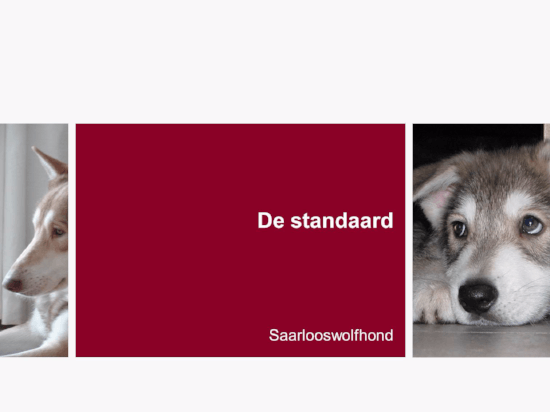


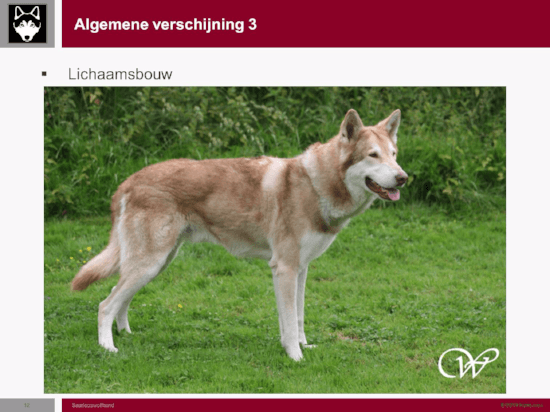
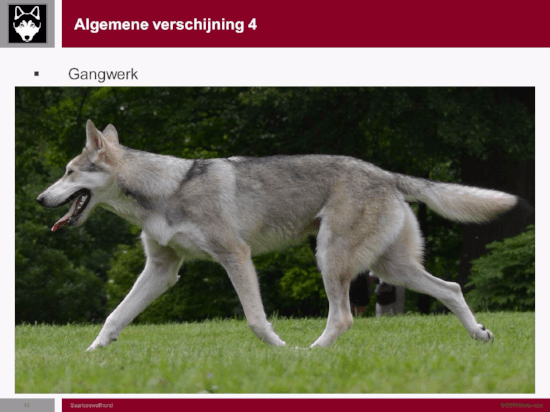
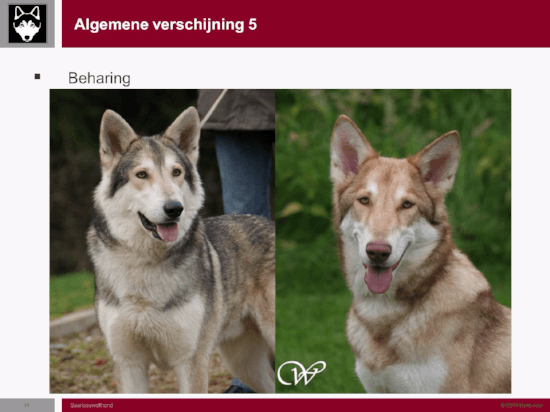
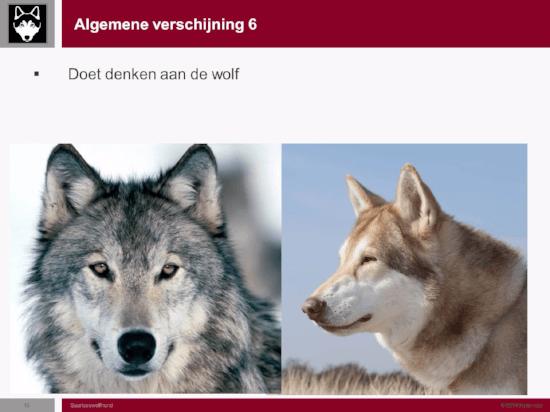
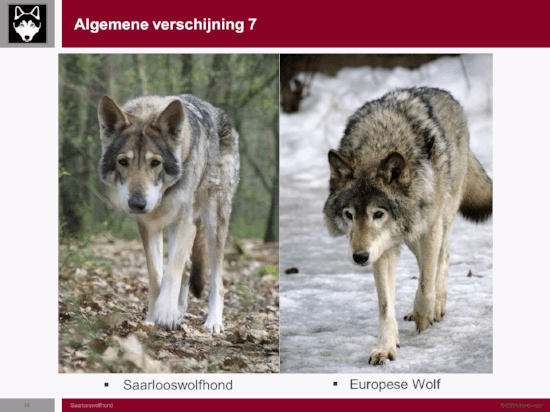
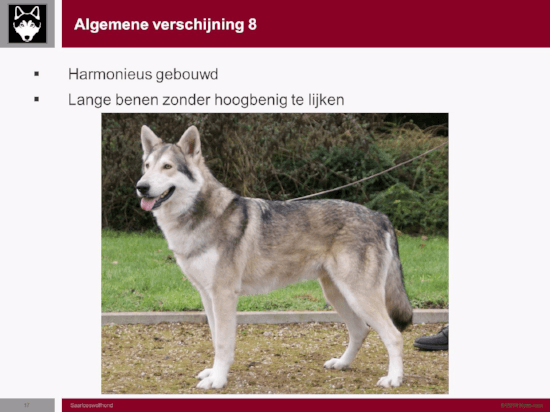
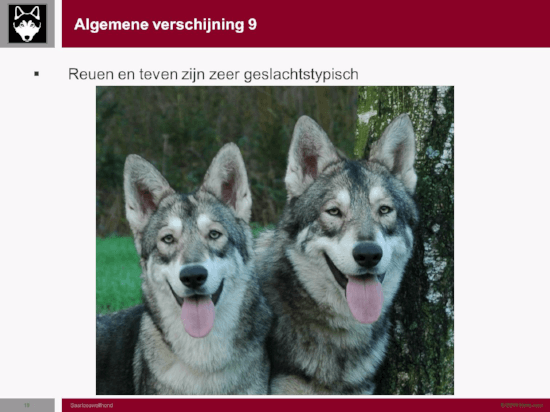
General appearance 1
General appearance 2
General appearance 3
General appearance 4
General appearance 5
General appearance 6
General appearance 7
General appearance 8
General appearance 9
Strongly built dog.
Exterior.
Body.
Gait/movements.
Coat.
Reminiscent of a wolf.
Left: Saarloos Wolfdog.
Right: European Wolf.
Construction is balanced.
Quite long limbs without giving the appearance of being long-legged.
The different secondary sexual characteristics are pronounced in dogs and bitches.
RASSTANDAARD SAARLOOSWOLFHOND
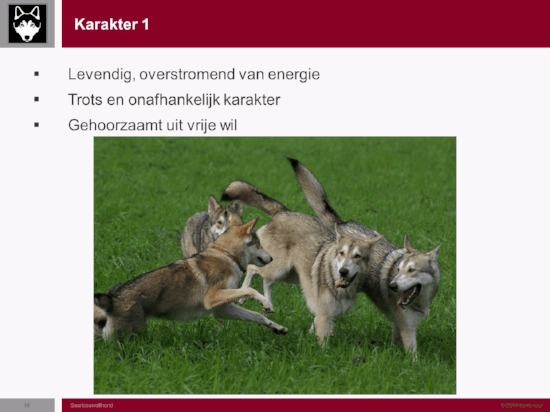
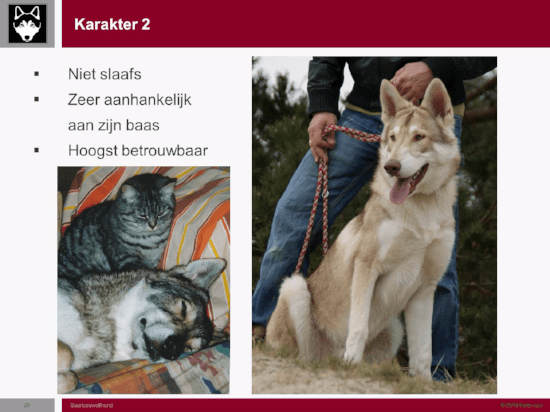

Behaviour/Temperament 1
Behaviour/Temperament 2
Behaviour/Temperament 3
A lively dog, bursting with energy.
With evidence of a proud independent character.
Obeys only of his own free will.
Not submissive.
Towards his master he is devoted.
Reliable to a high degree.
To-wards strangers he is reserved and somewhat suspicious.
His reserve and wolf-like wish to flee in unknown situations, are typical for the Saarloos Wolfdog.
Should be retained as typical qualities of the breed.
RASSTANDAARD SAARLOOSWOLFHOND
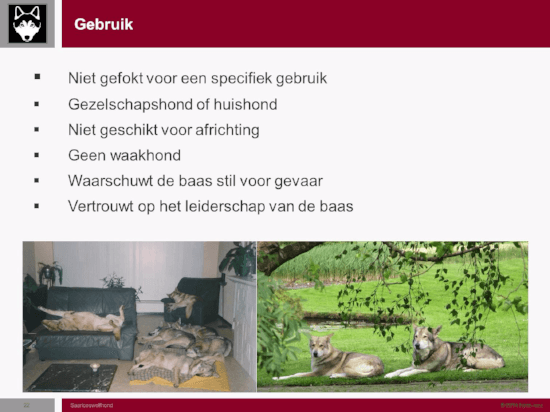
Use
Any aim for a particular utilization.
A faithful and reliable companion and house dog.
Not suitable for training.
Not a guard dog.
Warns in a quite way.
Relies at the leading capacitys of his master.
RASSTANDAARD SAARLOOSWOLFHOND
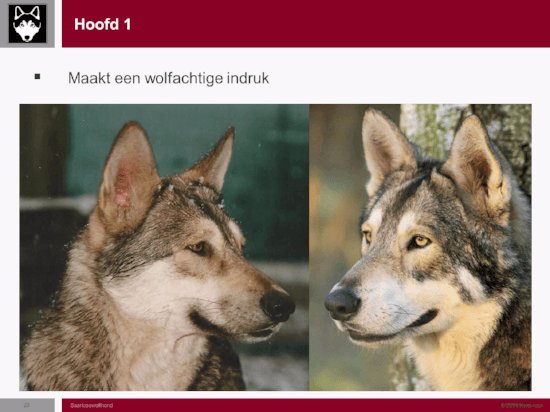
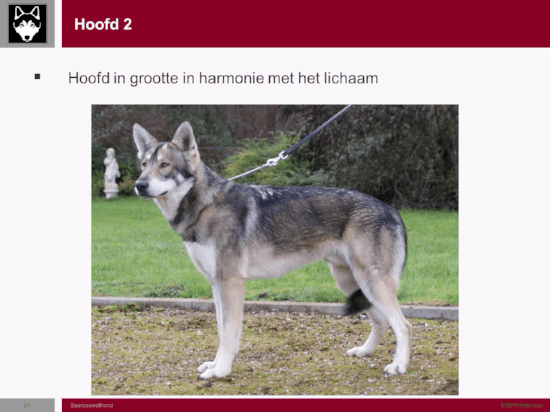
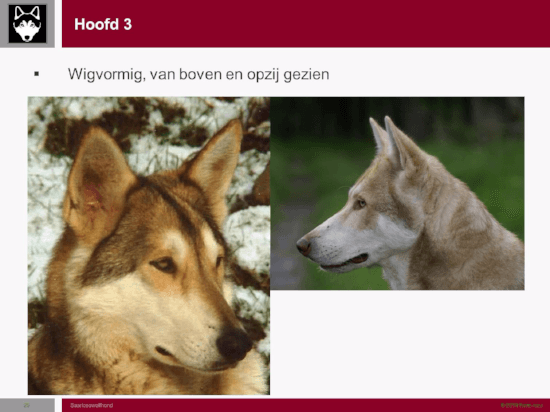
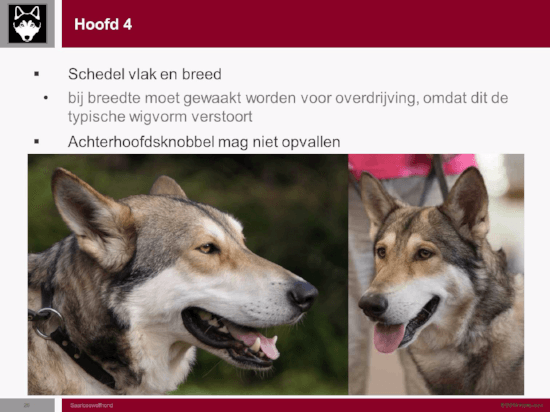
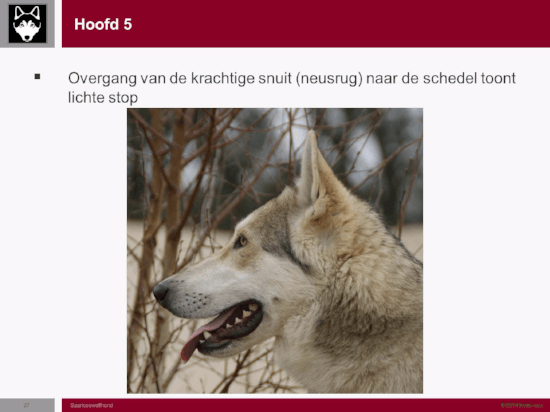
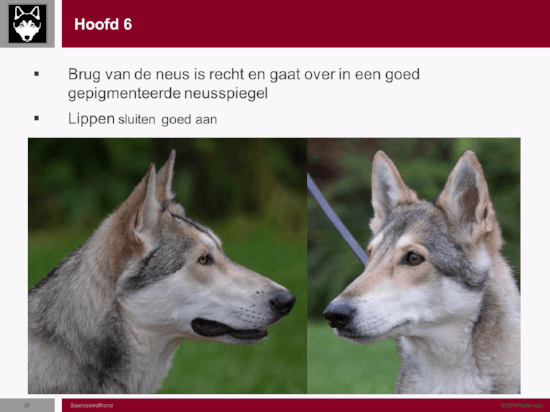
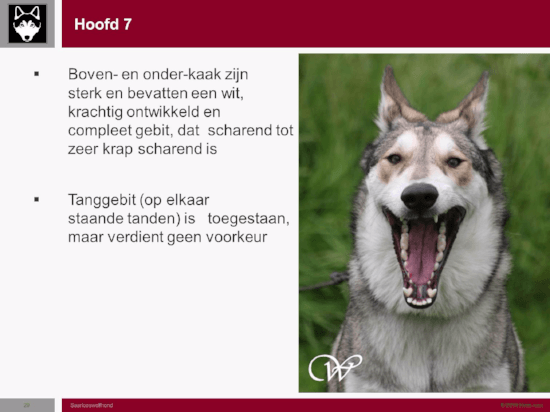
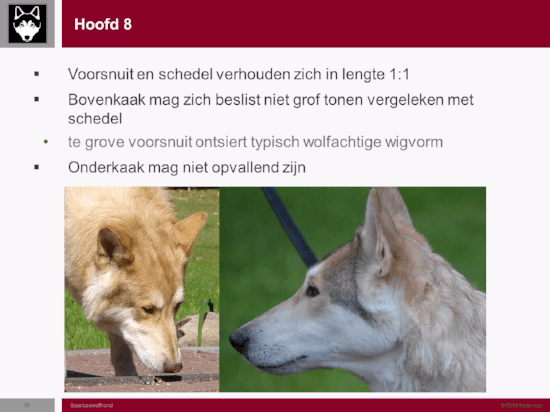

Head 1
Head 2
Head 3
Head 4
Head 5
Head 6
Head 7
Head 8
Head 9
Should give a wolf-like impression.
Size should be in harmonious relation to the body.
Seen from above and from the side, the head is wedge-shaped.
The skull is flat and broad.
- Exaggeration in respect to width must be warned against as this affects the typical wedge shape.
The occiput and the eye socket must not be noticeable.
The transition from the strong muzzle to the skull must form a slight stop.
Nose leather well pigmented.
Bridge of nose straight.
Upper and lower jaw are well developed and have a strong and com-plete scissor bite.
Also acceptable in the shape of a very close fitting scissor bite.
Relation muzzle - skull 1:1.
Must not appear coarse compared to the skull.
- Too coarse a muzzle disfigures the typical wolf-like shape.
Lower jaw : lot conspicuous.
Highly significant is the line in which the muzzle flows into a well-developed arch of the cheekbone.
RASSTANDAARD SAARLOOSWOLFHOND
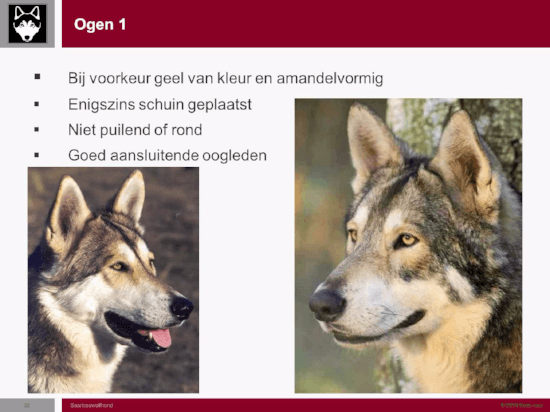
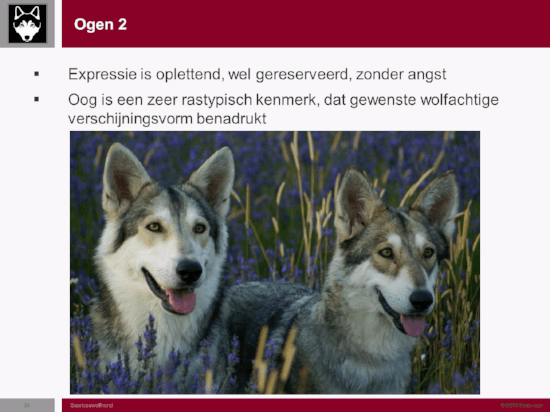
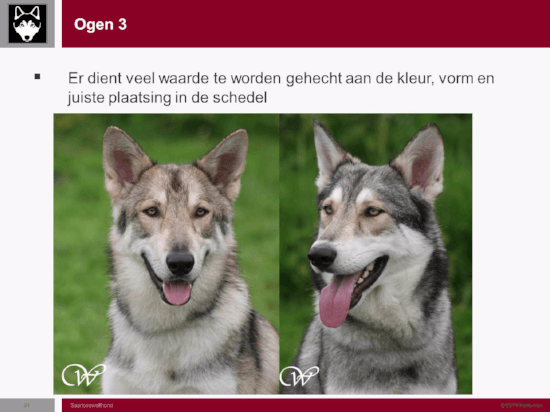
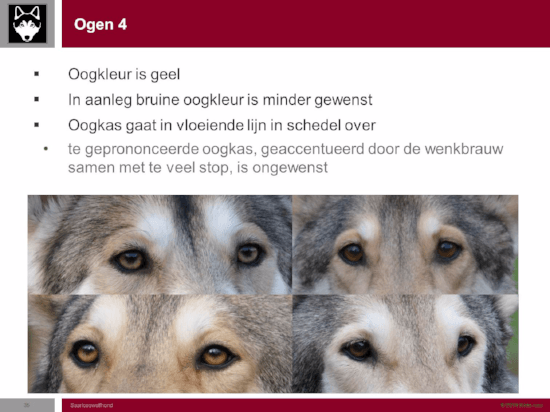
Eyes 1
Eyes 2
Eyes 3
Eyes 4
Preferably yellow, almond shaped.
Set slightly oblique.
Not protruding and not round.
Well fitting lids.
The expression is alert, reserved but not anxious.
The eye is a very typical characteristic of the breed which emphasizes the desired wolf-like appearance.
A great deal of value must be placed on the colour, shape and correct position in skull.
The eye is yellow.
Disposition to brown colour is less desirable.
The eye socket merges into the skull in a flowing line.
- An eye socket that is too pronounced together with a pronounced superciliary arch and a marked stop are undesirable.
RASSTANDAARD SAARLOOSWOLFHOND
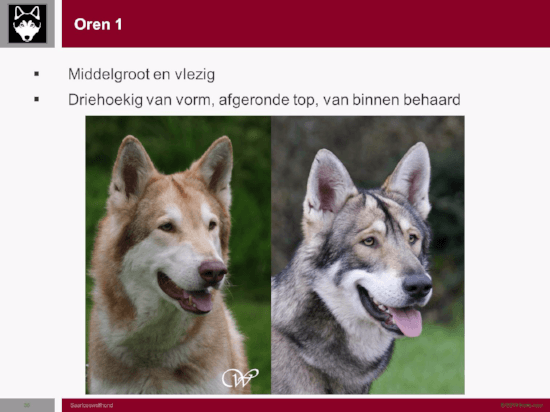

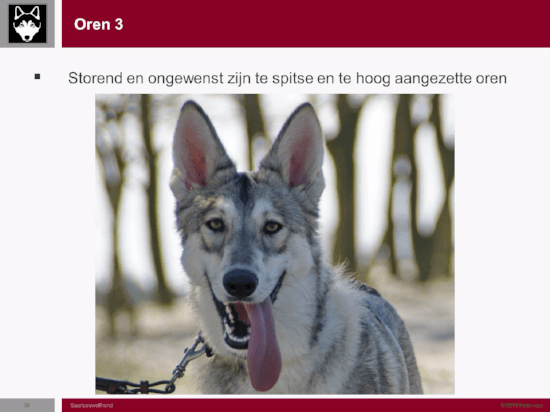
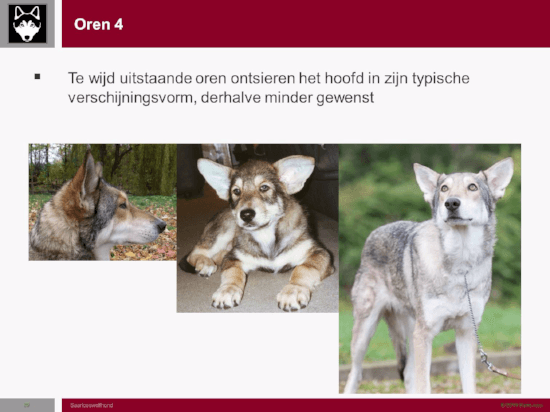
Ears 1
Ears 2
Ears 3
Ears 4
Medium size, fleshy.
Triangular with rounded tip. Hairy on inside.
The ear is set on at the level of the eyes.
Not desired are ears too pointed or set on too high.
Ears set too far apart laterally, disfigure the head in its typical appearance and are therefore less desirable.
RASSTANDAARD SAARLOOSWOLFHOND
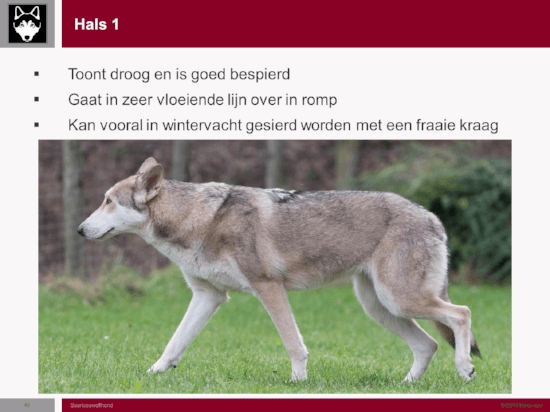
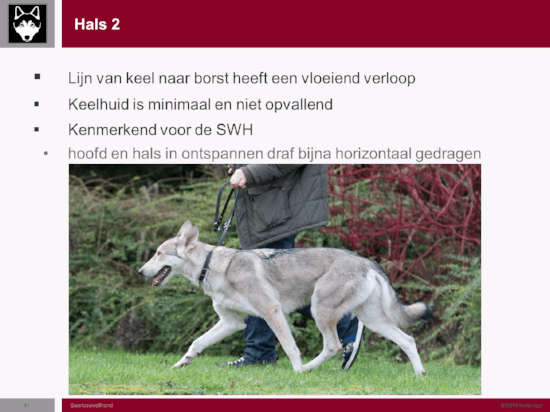
Neck 1
Neck 2
Dry and well muscled.
Merging with the back in a very flowing line.
The neck can, especially with a winter coat, be adorned by a beautiful collar (ruff).
Just as flowing is the line from the throat to the chest.
The skin of the throat is minimal and not conspicuous.
Typical of the Saarlooswolfdog.
- at a relaxed trot, head and neck form an almost horizontal line.
RASSTANDAARD SAARLOOSWOLFHOND
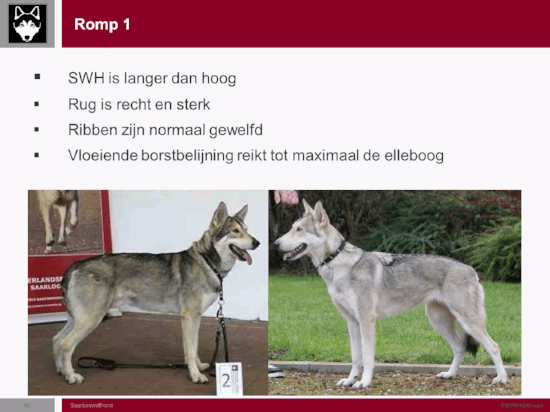

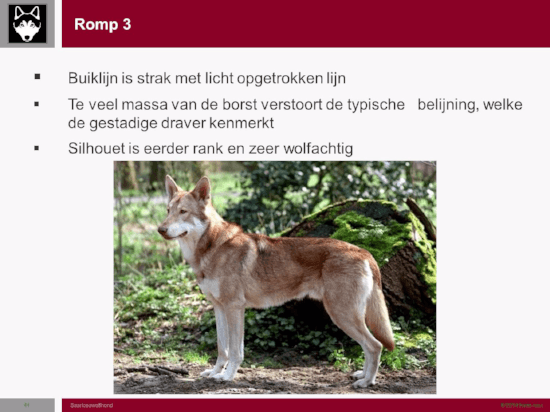
Body 1
Body 2
Body 3
Saarloos Wolfdog is longer than its height.
Back: Straight and strong.
Ribs : Normally sprung.
The flowing line of the brisket reaches, at the most, to the elbows.
Chest and distance between legs, seen from the front, appear moderately broad.
Taut and lightly tucked up.
Too massive a chest should be avoided as it disturbs the outline which typifies this steady trotter.
The outline is rather slim and very wolf-like.
RASSTANDAARD SAARLOOSWOLFHOND

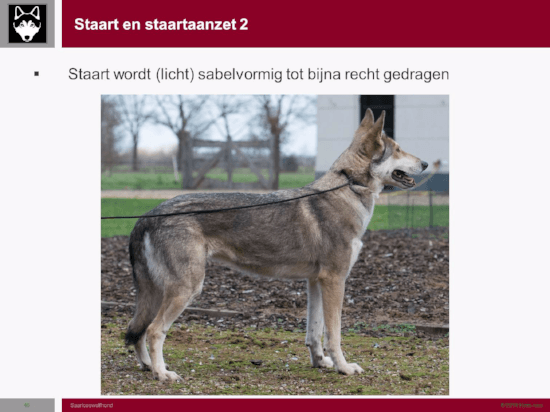
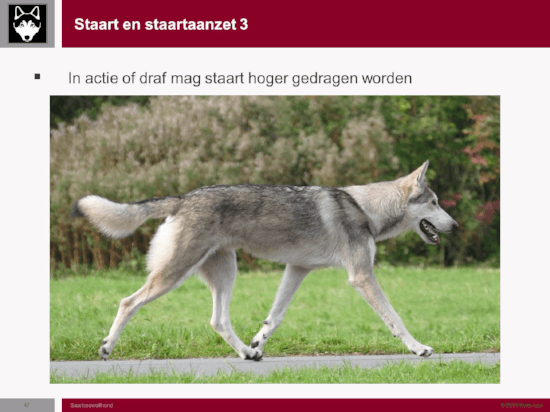
Tail and tail set 1
Tail and tail set 2
Tail and tail set 3
Broad and profusely coated at set on.
Reaching at least to the hocks.
Appears slightly low set, which is often accentuated by a slight depression at the set on.
The tail is carried lightly curved in sabre shape or almost straight.
It may be carried slightly higher in excitement or when the dog is trotting.
RASSTANDAARD SAARLOOSWOLFHOND
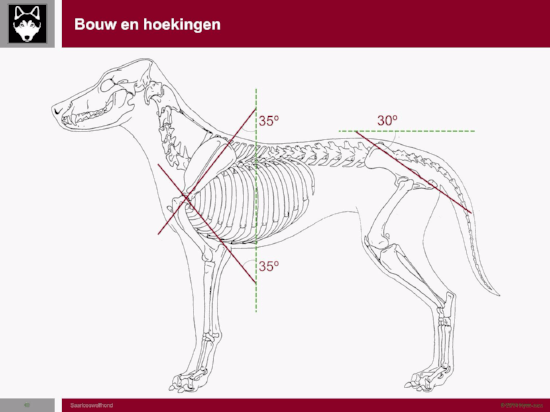
Construction and angulations
RASSTANDAARD SAARLOOSWOLFHOND
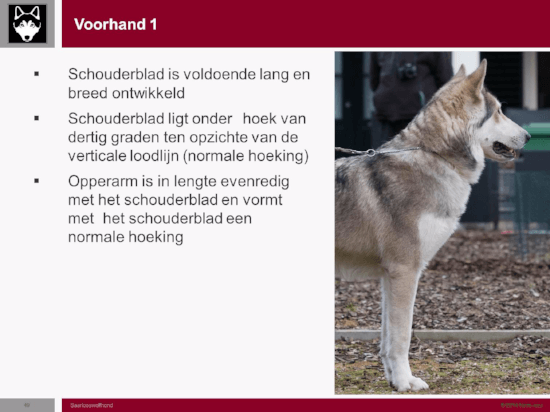
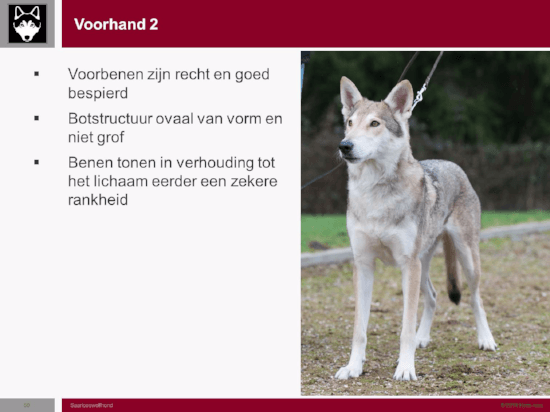
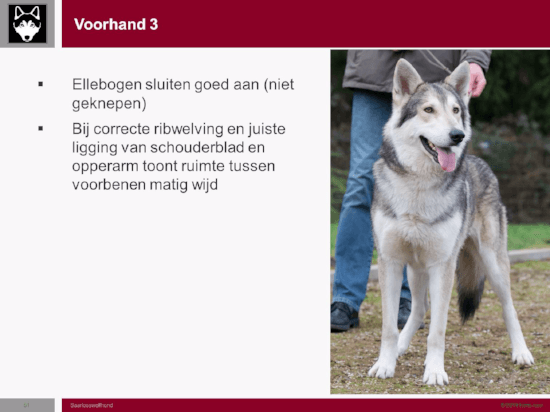

Forequarters 1
Forequarters 2
Forequarters 3
Forequarters 4
Shoulder: Sufficiently broad and long.
Normal angulation of about 30° to the verti-cal, not exaggerated.
Upper arm: Same length as shoulder-blade; angulation between shoulder-blade and upper arm normal, not exaggerated.
Legs are straight and well muscled.
Bone is oval in cross-section and not too coarse.
Legs rather show a certain grace in relation to body.
Elbow : Close fitting to thorax without being pressed close.
Due to the curve of the ribs and the correct position of the shoulder and the upper arm, the distance between the front legs is moderately broad.
Forefeet : Harefeet, well muscled and arched with strongly developed pads.
Strong carpal joints and the lightly sloping pasterns.
When standing, slight outward turn is permitted.
RASSTANDAARD SAARLOOSWOLFHOND

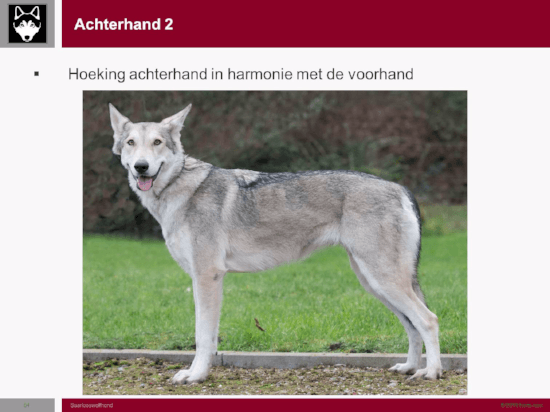

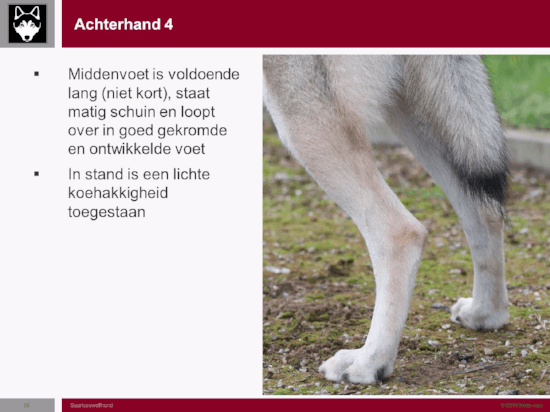
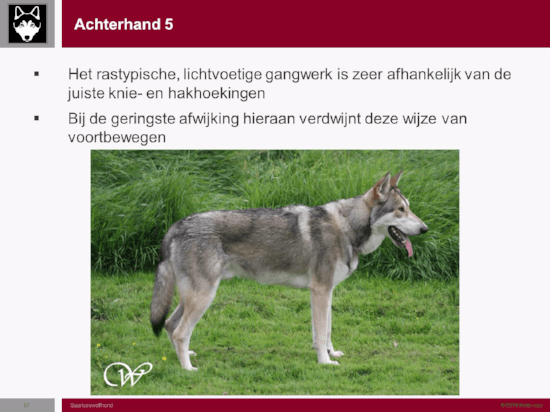
Hindquarters 1
Hindquarters 1
Hindquarters 1
Hindquarters 1
Hindquarters 1
Normal position of pelvis.
- Due to low tail set on, which is often accentuated by a slight depression, the pelvis, however often appears to be placed more obliquely.
Upper thigh: normal length and breadth, strongly muscled.
The angulation of the hindquarters is in balance with the angulation of the forequarters.
Stifle and hock joint : angulation not exaggerated.
Hocks : Sufficiently long (not short), medium slope. Bones and muscles permit optimal stretching of hock joints.
Sufficiently long (not short), medium slope.
Slight cow-hocks are permitted when standing.
The light movement, typical of the breed, is very dependant on the correct angulation of stifle and hock.
The slightest deviation prevents this typical movement.
RASSTANDAARD SAARLOOSWOLFHOND
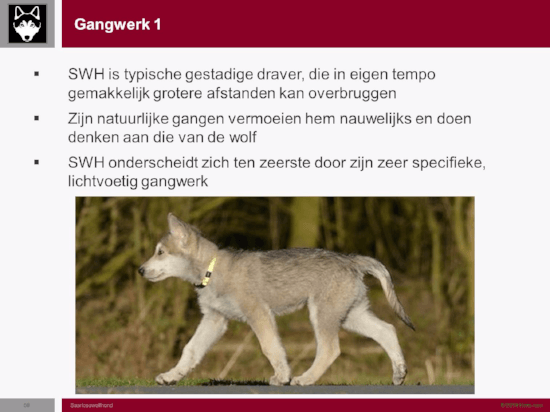


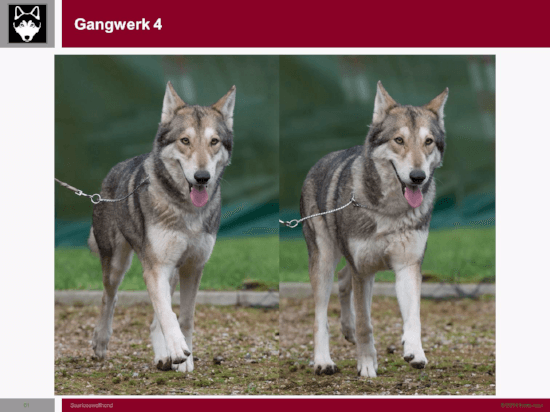


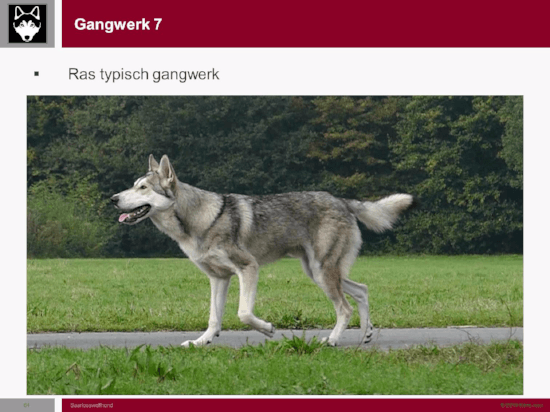

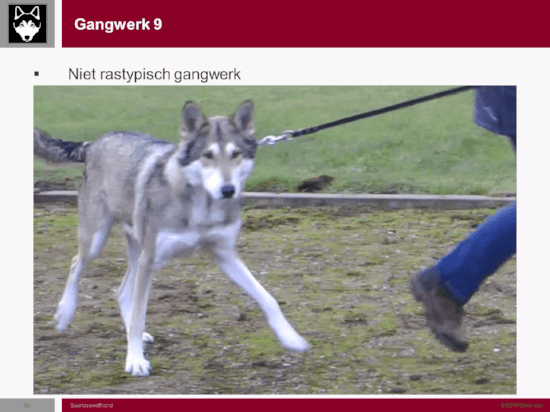
Gait/movement 1
Gait/movement 2
Gait/movement 3
Gait/movement 4
Gait/movement 5
Gait/movement 6
Gait/movement 7
Gait/movement 8
Gait/movement 9
The Saarloos Wolfdog is a typical untiring trotter, which can easily cover great distances at his own pace.
He barely tires by his natural movement and is reminiscent of the wolf.
The SWH differs greatly from other breeds through his very specific light-footed movement.
The correct forward movement is very dependent on different details in the construction of the body.
Above all, the correct angulation of the different limbs, is of great influence.
At a free unrestricted trot, the Saarloos Wolfdog carries head and neck at almost horizontal level.
In this position, the position of the eyes and the wedge shape of the head are particularly!
When trotting the typical light-footed movement is firm and resilient – especially on a natural ground the supple resilient wrist movement is characteristic.
At an untiring trot, which is the movement typical of the breed, the dog shows no great reach of the limbs because this, as well as too much drive, would spoil the light-footed movement.
The light movement, typical of the breed, is very dependant on the correct angulation of stifle and hock.
The correct angulation of the different limbs, is of great influence.
Movement, a-typical for the breed.
RASSTANDAARD SAARLOOSWOLFHOND
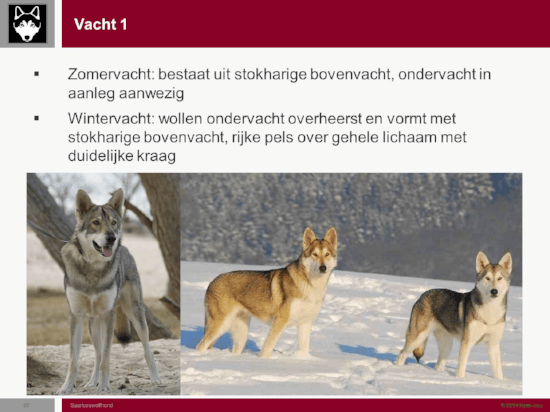
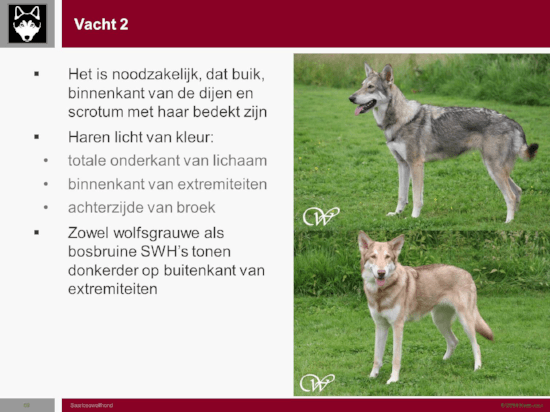

Coat 1
Coat 2
Coat 3
Summer coat: the guard hair of the topcoat predominates.
Winter coat: the undercoat predominates mostly, which together with the guard hair of the topcoat forms a profuse coat, covering the whole body and forming a distinct collar (ruff) round the neck.
It is essential that the belly, the inside of the upper thighs and the scrotum are covered by hair.
Hair is light of color:
- whole underside of the body.
- on the inner side of the limbs.
- at the back of the breeches.
The wolf-gray as well as the « (forest) bos »-brown Saarlooswolfdog show a dark colour on the outside of the limbs.
They should also have an expressive mask.
RASSTANDAARD SAARLOOSWOLFHOND
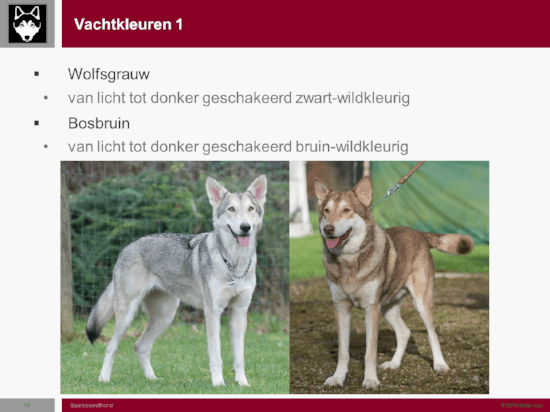

Coat Colors 1
Coat Colors 2
Wolf-gray.
- From light to dark shaded black-game colour.
bos »-brown (Bos = forest).
From light to dark shaded brown-game colour.k-game colour.From light to dark shaded black-game colour.
From light creamy white to white.
RASSTANDAARD SAARLOOSWOLFHOND

Pigment
Pigment of nose, eye rims, lips and toenails:
- black in a wolf-gray and white Saarloos Wolfdog.
- In « bos »-brown or cream white dogs it should be liver coloured.
RASSTANDAARD SAARLOOSWOLFHOND
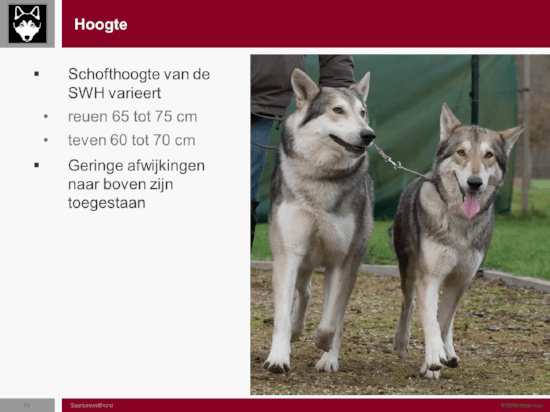
Grootte
Height at the withers : Varies in the Saarloos Wolfdog.
- Male dogs : From 65 to 75 cm.
- Bitches : From 60 to 70 cm.
Slight deviations upwards are permissible.
RASSTANDAARD SAARLOOSWOLFHOND
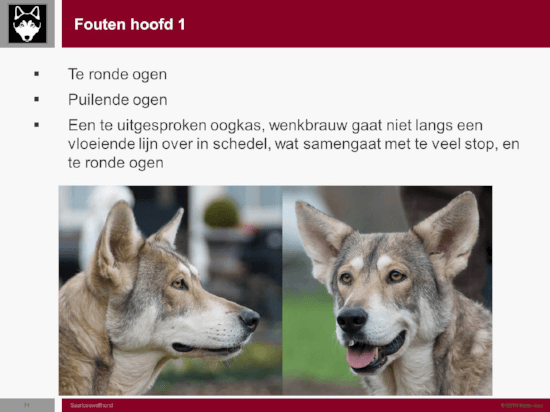
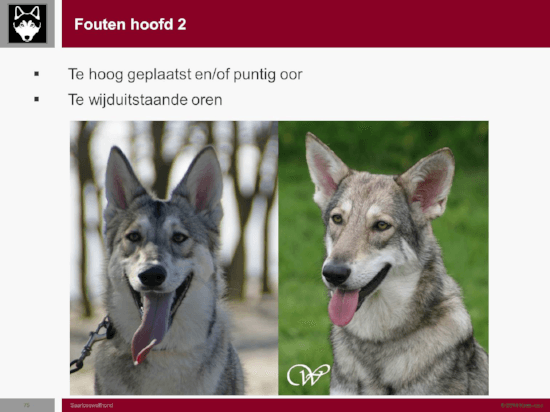

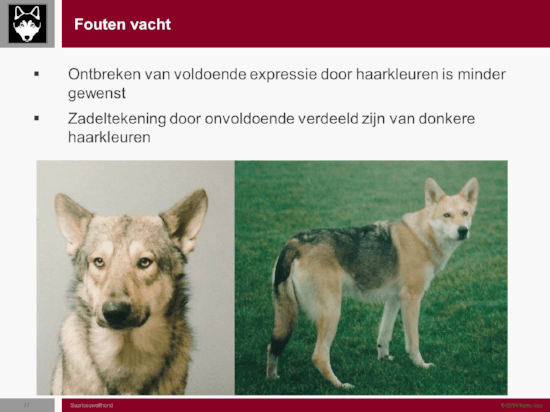

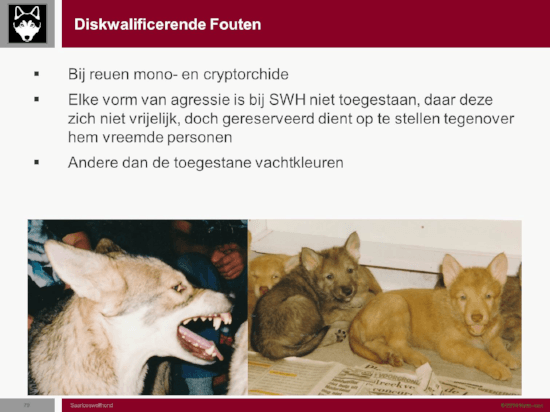
Faults head 1
Faults head 2
Faults body
General appearance 4
Faults tail
Disqualifying faults
Too round.
Protruding eyes.
Too pronounced eye sockets so that the superciliary ridges do not merge with the skull in a flowing line. This often occurs with a pronounced stop and too round eyes.
Ears set on too high and or pointed ears.
Ears pointing too far outwards.
Too deep.
Too coarse in bone.
Too short.
Lack of expression caused by not sufficiently intense colours is less desirable.
Formation of a dark saddle due to poor distribution of dark hair.
Curly tail.
Tail carried over back.
Males mono- and cryptorchide.
Aggressive or overly shy.
Coat colour other than those permitted.
RASSTANDAARD SAARLOOSWOLFHOND
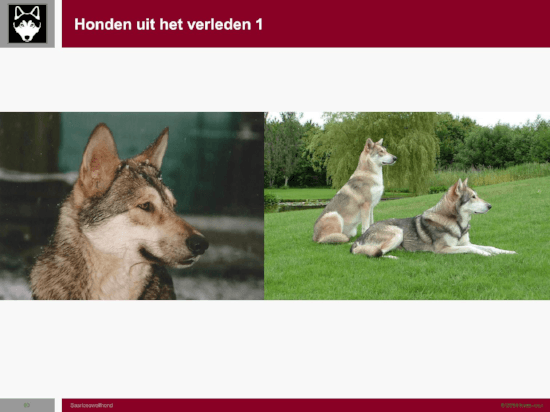
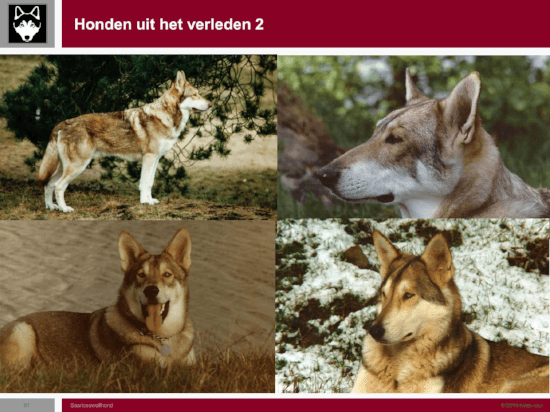


Dogs from the past 1
Dogs from the past 2
Saarloos Wolfdog
Eind
RASSTANDAARD SAARLOOSWOLFHOND


